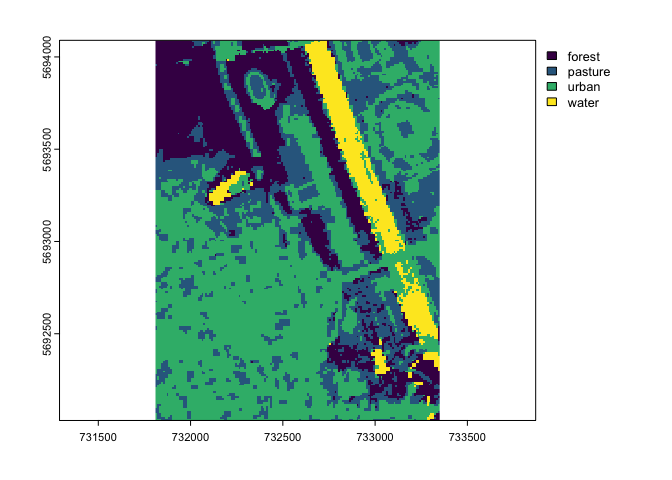

Package website: release | dev
mlr3spatial is the package for spatial objects within the mlr3 ecosystem. The package directly loads data from sf objects to train any mlr3 learner. The learner can predict on various raster formats (terra, raster and stars) and writes the prediction raster to disk. mlr3spatial reads large raster objects in chunks to avoid memory issues and predicts the chunks in parallel. Check out mlr3spatiotempcv for spatiotemporal resampling within mlr3.
Install the last release from CRAN:
install.packages("mlr3spatial")Install the development version from GitHub:
remotes::install_github("mlr-org/mlr3spatial")library(mlr3)
library(mlr3spatial)
library(terra, exclude = "resample")
library(sf)
# load sample points
leipzig_vector = read_sf(system.file("extdata", "leipzig_points.gpkg",
package = "mlr3spatial"), stringsAsFactors = TRUE)
# create land cover task
task = as_task_classif_st(leipzig_vector, target = "land_cover")
task## <TaskClassifST:leipzig_vector> (97 x 9)
## * Target: land_cover
## * Properties: multiclass
## * Features (8):
## - dbl (8): b02, b03, b04, b06, b07, b08, b11, ndvi
## * Coordinates:
## X Y
## 1: 732480.1 5693957
## 2: 732217.4 5692769
## 3: 732737.2 5692469
## 4: 733169.3 5692777
## 5: 732202.2 5692644
## ---
## 93: 733018.7 5692342
## 94: 732551.4 5692887
## 95: 732520.4 5692589
## 96: 732542.2 5692204
## 97: 732437.8 5692300# create learner
learner = lrn("classif.rpart")
# train the model
learner$train(task)
# load raster file
leipzig_raster = rast(system.file("extdata", "leipzig_raster.tif", package = "mlr3spatial"))plotRGB(leipzig_raster, r = 3, g = 2, b = 1)
# create prediction task
task_predict = as_task_unsupervised(leipzig_raster)
# predict land cover map
land_cover = predict_spatial(task_predict, learner)plot(land_cover, col = c("#440154FF", "#443A83FF", "#31688EFF",
"#21908CFF", "#35B779FF", "#8FD744FF", "#FDE725FF"))
Eventually. It is not yet clear whether these would live in
mlr3extralearners or in mlr3spatial. So far there are none yet.
mlr3spatiotempcv is solely devoted to resampling techniques.
There are quite a few and keeping packages small is one of the
development philosophies of the mlr3 framework. Also back in the days
when mlr3spatiotempcv was developed, it was not yet clear how we want to
structure additional spatial components such as prediction support for
spatial classes and so on.